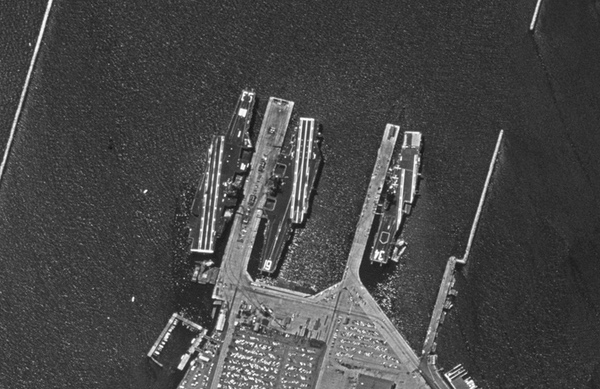Carriers—and battleships—from space (part 3): The Mighty O and the Mighty Moby Dwayne A. Day and Harry Stranger
|
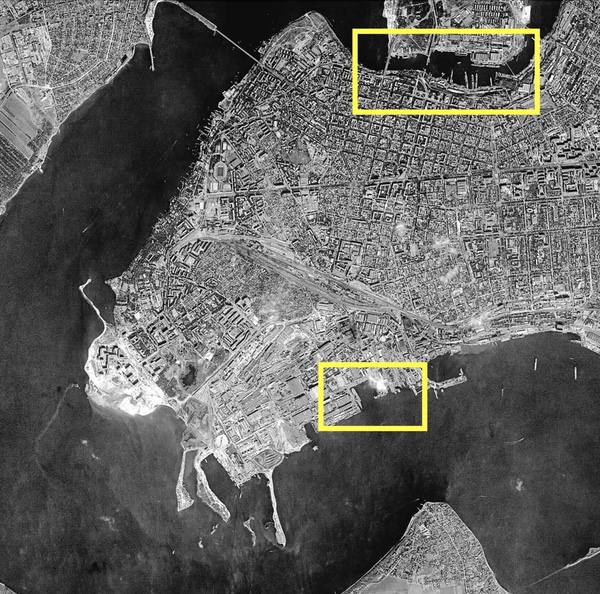 The shipyards at Nikolaev in Ukraine produced many new and powerful Soviet warships during the late 1970s and early 1980s. This HEXAGON satellite image shows the location of shipyards producing guided missile cruisers and aircraft carriers. (credit: Harry Stranger) |
While this was happening, the US Navy was shrinking rapidly in size due to the retirement of hundreds of World War II-era ships that had reached the end of their lifetimes and were incapable of modernization. In the previous decade, the fleet had declined from just under 1,000 to 450 ships, and combat aircraft had reduced from 2,700 to 1,700. In 1979–1980, the General Accounting Office evaluated the possibility of modernizing and extending the lifetime of nineteen World War II-era Gearing-class destroyers, but determined this would be expensive. By 1980, some in the US Navy and Congress began discussing refurbishing several larger mothballed ships, including the aircraft carrier Oriskany, and the four battleships of the Iowa class (something that is in the news again).
  The Slava class guided missile cruisers were building in the early 1980s. The first one is seen here in a HEXAGON reconnaissance satellite photo before the installation of its cruise missiles. This ship was named Moskva and was sunk by Ukraine in April 2022. (credit: Harry Stranger) |
Until Soviet warships sailed into the open ocean, the primary method the United States had for gathering intelligence about them was satellite photography. And although the Soviets had access to American newspapers that regularly reported on the Department of Defense’s budget and plans, they did not trust the American press and relied on their own satellites to monitor the US Navy. Soviet satellites were photographing mothballed American warships at several ship storage yards on the East and West Coasts, looking for evidence that the Americans were planning to reactivate their battleships and older aircraft carriers. (See “Flattops from space: the once (and future?) meme of photographing aircraft carriers from orbit,” The Space Review, July 19, 2021; “Carriers from space (part 1),” The Space Review, July 15, 2024; “Carriers from space (part 2): Contemporary use of satellite imagery for open source intelligence,” The Space Review, August 12, 2024.)
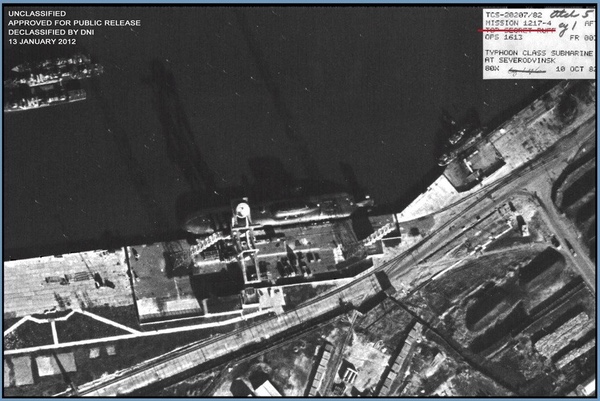 HEXAGON satellite photo of a massive Soviet Typhoon-class submarine in 1982. The Soviet Union began launching new and impressive warships in the late 1970s/early 1980s, prompting a naval buildup by the United States. (credit: NRO) |
The age of battleships reborn
By late 1980, the CIA had estimated that a total of 17 ships, of eight different classes of major surface combatants, were either under construction or outfitting at Soviet naval shipyards. Kirov had completed sea trials and was beginning operational work-ups (see “HEXAGON vs. Kirov: American satellite reconnaissance and the Soviet Union’s most powerful warship,” The Space Review, September 23, 2024.) It was the Kirov in particular that had prompted talk about reactivating the four Iowa-class battleships. Although technically a cruiser, Kirov was commonly referred to as a “battlecruiser” because of its size and armament. The Typhoon, the largest submarine ever built, also generated concern in the US Navy (see “Hunting Red October,” The Space Review, April 18, 2016.)
World War II had definitively demonstrated that aircraft carriers and submarines were the future of naval warfare and battleships were relics. Nevertheless, the United States kept a decreasing number of battleships in the fleet following the war, quickly sending most of them to reserve “mothball” status, or scrapping them. The four Iowa-class battleships, the last built for the United States, and generally regarded as the best battleships ever built, were decommissioned several times, and apparently for the last time by the late-1950s—Wisconsin and Iowa at the Philadelphia Navy Yard, and Missouri and New Jersey on the West Coast. The USS New Jersey was recalled to active service in 1968 to provide gunnery support to troops ashore in Vietnam. She was substantially modernized at that time. Of the other three ships, USS Missouri—known as “The Mighty Mo” to her crews—was the most famous, because the Japanese surrender at the end of World War II was signed on her decks. USS Iowa and Wisconsin, like the Mighty Mo, had been in mothballs since the 1950s.
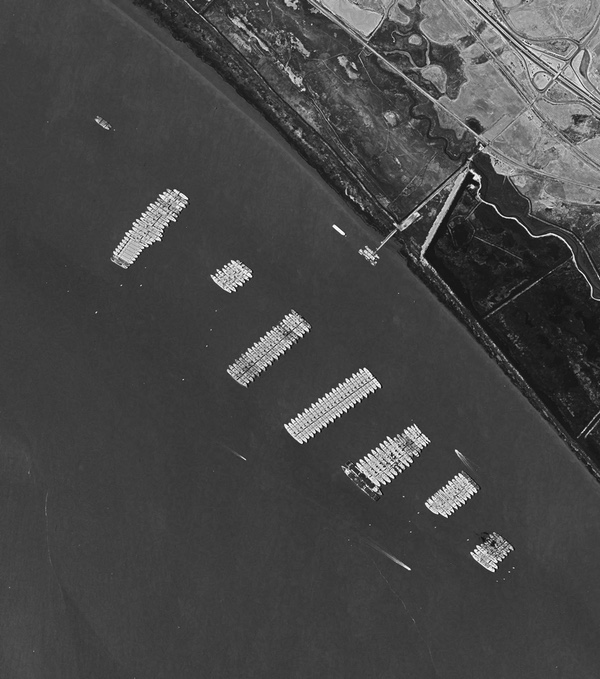 This 1978 HEXAGON reconnaissance satellite photo shows one of several "mothball fleets" in the United States containing hundreds of decommissioned warships and transports. These ships were often held in reserve in the expectation that they could be reactivated if needed, but the costs of doing so were high. (credit: Harry Stranger) |
In 1977, the US Navy evaluated several concepts for modernizing the Iowa battleships. By 1980, the Navy’s plan for the four battleships was to remove several of their five-inch guns and replace them with armored box launchers for Tomahawk cruise missiles, which could be equipped with nuclear warheads. One concept for the New Jersey was to remove the battleship’s rear 16-inch turret and install a vertical missile launcher system with an additional 48 Tomahawk/Harpoon missile launchers. Another alternative was to install equipment to support helicopters and/or vertical/short take-off and landing aircraft.
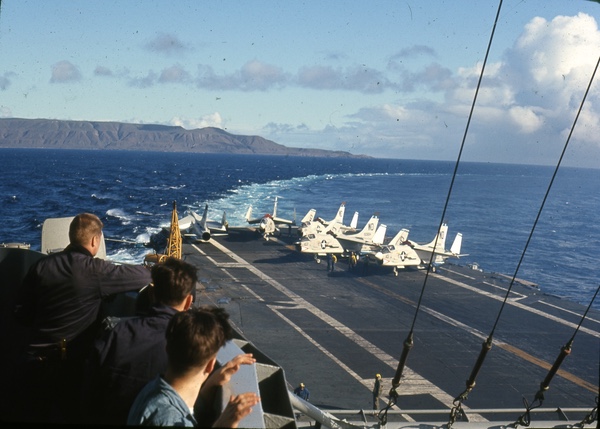 Oriskany operations off the coast of California during training. Oriskany was the last Essex-class aircraft carrier to be completed. (credit: US Navy) |
The Oriskany
USS Oriskany was the last of the World War II Essex-class carriers completed, although not the last ordered. Launched after the war on October 13, 1945 and named for a Revolutionary War battle, the ship was not commissioned until September 25, 1950, equipped with the latest upgrades. She was decommissioned in January 1957 for modernization and recommissioned in March 1959 with an angled flight deck and other modifications.
As the Vietnam War heated up, Oriskany was sent to the Western Pacific to support the war effort. In June 1966, Oriskany reached Yokosuka, Japan and was then sent to “Dixie Station” off South Vietnam. The carrier shifted to “Yankee Station” in the Gulf of Tonkin in July. The ship and her air wing saw heavy action, launching 7,794 combat sorties.
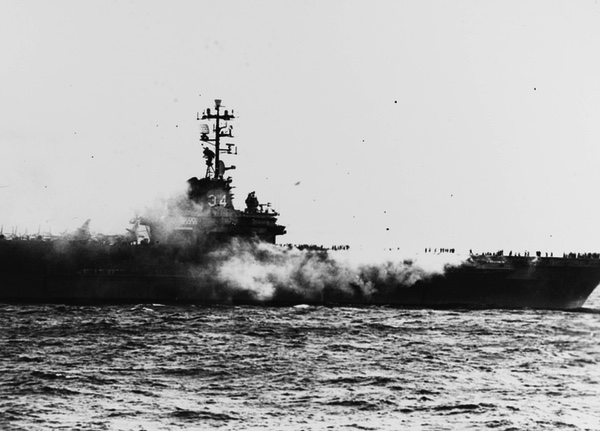 USS Oriskany in 1966 during a devastating fire that killed dozens of sailors. (credit: US Navy) |
On October 26, 1966, while Oriskany was on station, a fire erupted on the starboard side of the ship’s forward hangar bay. It quickly traveled through five decks, killing 44 men. The fire was started by a magnesium parachute flare that caused an explosion in the forward flare locker, beneath the flight deck. This was the first of three devastating fires aboard American aircraft carriers in the later 1960s, the most devastating being a fire aboard USS Forrestal in 1967, followed by another on USS Enterprise in January 1969.
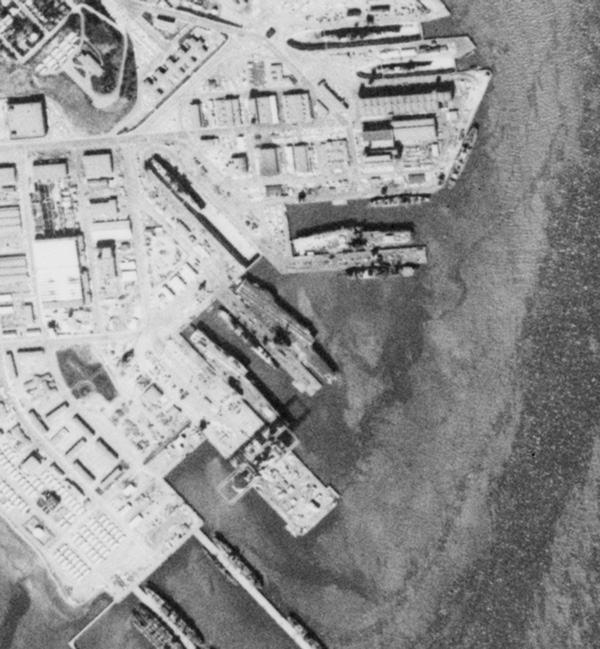 USS Oriskany in San Francisco in March 1967 after being repaired after the fire. (credit: Harry Stranger) |
In 1967, Oriskany returned to Yankee Station off Vietnam. In July, she provided medical assistance to the fire-ravaged attack carrier USS Forrestal. On October 26, 1967, then-Lieutenant Commander John McCain flew off Oriskany in an A-4 Skyhawk. It was his 23rd bombing mission of the Vietnam War. McCain was shot down and became a prisoner of war until January 1973.
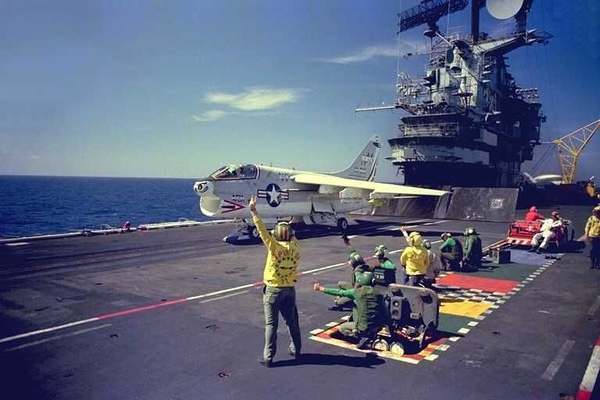 Flight operations on USS Oriskany during the Vietnam War. The ship launched many sorties and suffered the loss of many planes. Lieutenant John McCain flew from Oriskany and was shot down, becoming a prisoner of war. He later became a US senator. (credit: US Navy) |
Oriskany began heading home in mid-January 1968. During the combat tour, Carrier Air Wing 16 suffered perhaps the highest loss rate of any naval air wing during the Vietnam War. Twenty-nine planes were lost in combat, and another ten were lost due to operational causes; the wing lost half of its assigned planes. Peter Fey later wrote the book Bloody Sixteen about the carrier’s losses.
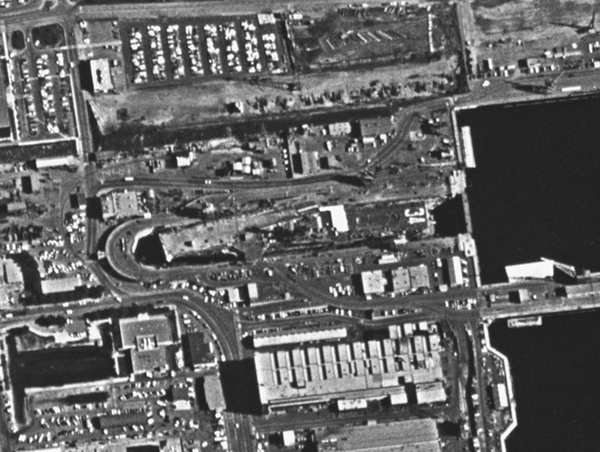 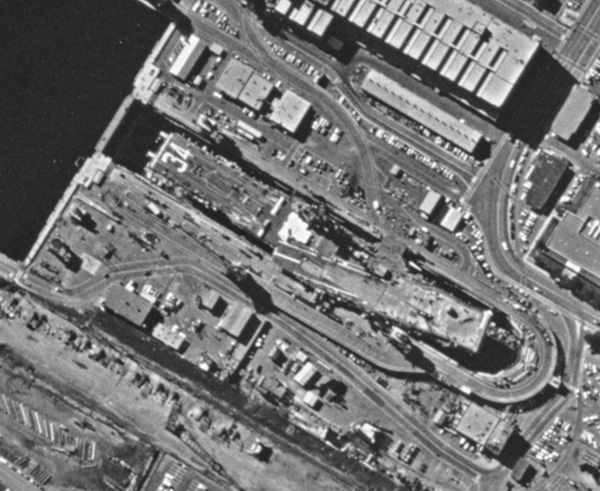 USS Oriskany in drydock in Long Beach, California during winter 1974/1975, photographed by a HEXAGON reconnaissance satellite. The ship was used hard during her service and twice lost a propeller during operations. (credit: Harry Stranger) |
Known as “The Mighty O” to her crews, Oriskany was used hard during the war: she twice lost a propeller and had to be repaired. She continued in service into the early 1970s and was finally decommissioned on September 30, 1976. USS Lexington, a sister ship, continued to serve in a training role. Oriskany appeared in many American satellite photographs over the years. She never served as a space recovery ship but did make a brief appearance as the Mars spacecraft recovery vessel in the 1978 movie Capricorn One.
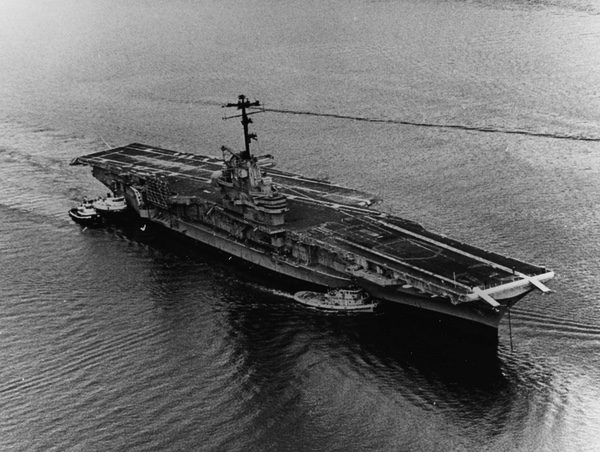 USS Oriskany after being retired in 1976. Although never used as a space recovery ship, it was depicted as the Mars spacecraft recovery ship in the movie Capricorn One. (credit: US Navy) |
Reactivating Oriskany and the battleships
In 1980, the Navy had 13 aircraft carriers in the fleet, including three nuclear-powered carriers, but operational requirements for at least two more. The proposal for Oriskany made in 1979 or 1980 was to use the ship as a limited capability carrier. The ship would be equipped with A-4M attack aircraft with day-only attack capabilities. Although it was physically possible to modernize Oriskany to handle the brand-new F/A-18 Hornet, which had all-weather, day/night and attack/fighter capability, doing so was considered too expensive. The A-4M was not an all-weather aircraft and required visual sighting before attacking a target, but it was still in service with the Marine Corps, and Oriskany had operated the planes before. The Oriskany would only carry attack aircraft, not defensive fighters. In medium and high-threat areas the ship would require a large deck carrier and support ships for protection against aircraft and submarines. Oriskany would also not have a close-in weapons system for defense.
Two squadrons of 24 A-4M aircraft each, from the 2nd and 3rd Marine Air Wings, would be deployed aboard Oriskany, along with four SH-3 Sea King helicopters for support. Although originally designed as a carrier aircraft, the A-4M had gotten heavy over the years and the landing gear would have to be modified to allow maximum gross weight carrier landings. The Navy was also considering the deployment of AV-8 Harrier vertical take-off aircraft.
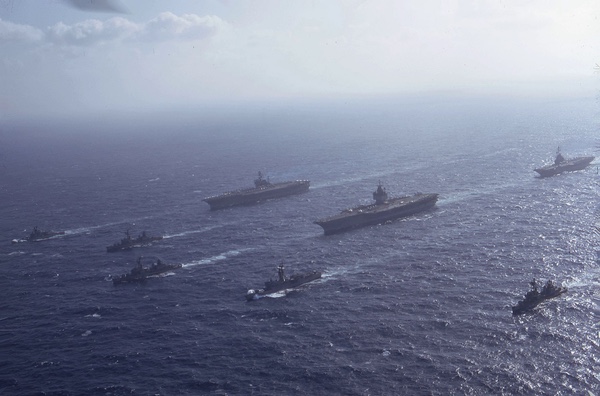 Aircraft carriers USS Oriskany (rear), USS Enterprise (foreground) and USS Ranger (background) in the Pacific Ocean in the early 1970s. All three ships were also photographed from space when docked in Alameda. (credit: US Navy) |
The Navy’s plan was to operate Oriskany in conjunction with a Marine amphibious unit and to support a Rapid Deployment Force. Whereas the Navy’s large “supercarriers” had multi-purpose missions including projecting force ashore, controlling sea lanes, and hunting submarines, the Oriskany would be much more limited to supporting Marines ashore.
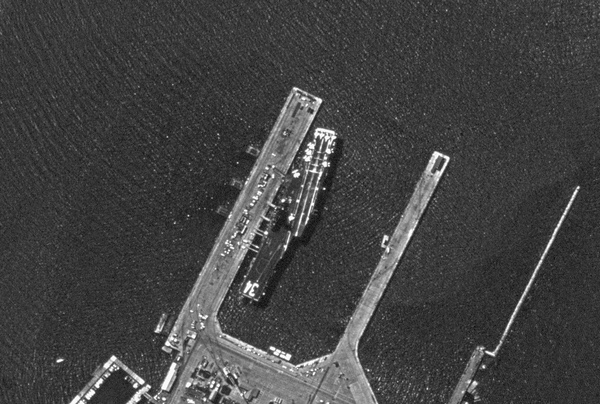 USS Oriskany at Alameda in March 1973. The base is now home to Oriskany's sister ship, USS Hornet, which is a museum. It was also the location where Pavel Chekov was captured for infiltrating the nuclear-powered aircraft carrier USS Enterprise. (credit: Harry Stranger) |
It is not clear when discussion of reactivating Oriskany first started, but in July 1980 Secretary of Defense Harold Brown wrote a memorandum to President Jimmy Carter about the status of current weapons systems. He indicated that he planned to meet soon with members of Congress and among other things, argue vigorously against reactivating the New Jersey and the Oriskany. Satellite photos of the sea trials of the Soviet Kirov battlecruiser and other large warships undoubtedly prompted discussion of reactivating Oriskany and the New Jersey.
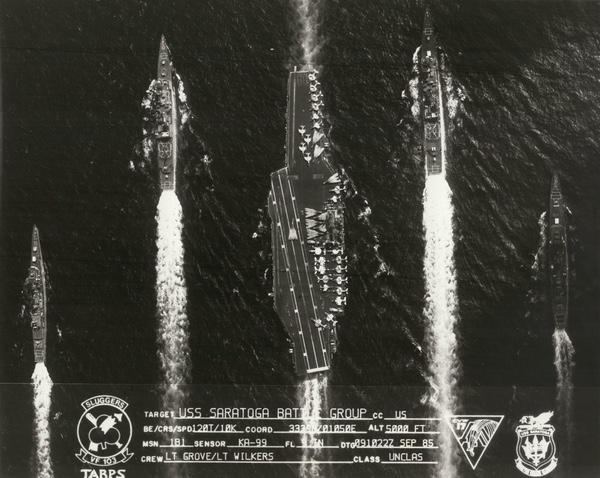 USS Saratoga photographed from an F-14 Tomcat. Saratoga underwent a service life extension in the late 1970s that cost half a billion dollars, the same as the cost estimate for reactivating USS Oriskany, which was much smaller and less capable. (credit: US Navy) |
By April 1981, the Navy estimated the cost of reactivating Oriskany at $518 million. This would extend the ship’s lifetime by 10 to 15 years. The estimate had increased substantially over an earlier estimate that would have performed minimal work on the ship and extended its lifetime by only five years. The aircraft carrier Saratoga had recently entered a life extension program and the cost and estimated labor hours required to extend the operational life of the Sara was equivalent to that estimated for Oriskany, despite the fact that Saratoga displaced about twice as much tonnage and was capable of operating a larger, modern air wing. Simply put, the Oriskany reactivation would be expensive, for limited additional capability.
The Navy estimated that it would cost $247 million to reactivate the battleship New Jersey, and $384 million to reactivate the battleship Iowa. Cost estimates for the reactivation of the Missouri and Wisconsin had not been developed. Some Navy officials believed the New Jersey’s estimate was too low and a more realistic estimate would be $305 million.
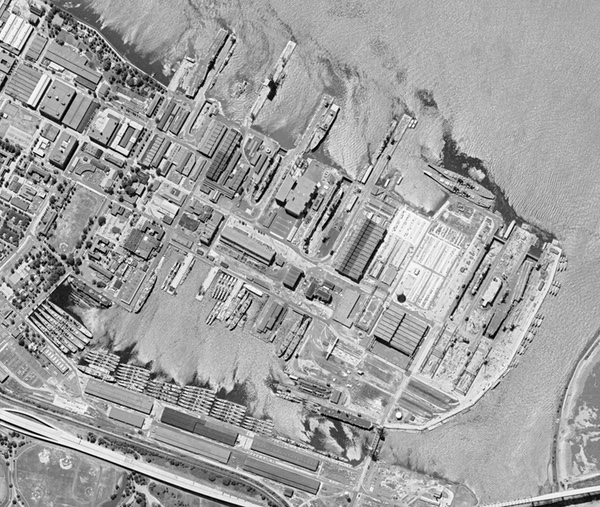 HEXAGON satellite photo of decommissioned warships at the Philadelphia Navy Yard in July 1974. The battleships Iowa and Wisconsin are at right. Also visible at upper left is the aircraft carrier USS Shangri-La, which was a sister ship to USS Oriskany and then being used to supply parts to the training carrier USS Lexington. (credit: Harry Stranger) |
The Navy’s best estimates were that it would take 36 months to plan and overhaul Oriskany, 21 months to plan and overhaul New Jersey, and 31 months for each of the remaining three battleships. But none of the ships had undergone recent extensive inspection to determine the status of their machinery and hulls. That could affect the schedules and budgets.
When the New Jersey was reactivated in 1968, much of its equipment was replaced and upgraded. The other three battleships had been inactive since the 1950s. The Navy’s last inspection of the Oriskany found her unfit for further service. That did not mean the ship was unrepairable, only that it required a greater degree of repair.
When Ronald Reagan became president in January 1981, one of his major goals was to begin a substantial defense buildup. This included actions such as reversing the cancellation of the B-1 bomber and pursuing the development of the MX ICBM, later named the “Peacekeeper.” Reagan’s Navy Secretary, John Lehman, began pursuit of a “600-ship Navy,” including reactivating Oriskany and the four Iowa-class battleships. In March 1981, Lehman proposed reactivating Oriskany.
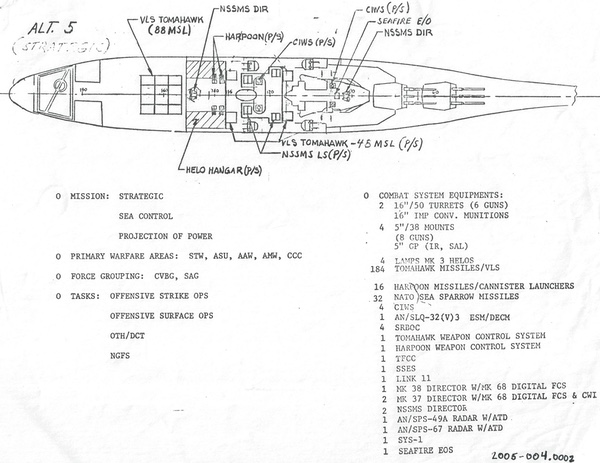 One of several proposed modifications to the Iowa-class battleships made in 1981. This proposal would have replaced the USS New Jersey's aft turret with a vertical launch system for Tomahawk and Harpoon cruise missiles. Other proposals would have replaced the aft turret with a short flight deck for Harrier vertical take-off and landing jets. These more extensive modifications were rejected and instead the four battleships had some of their 5-inch gun turrets replaced with armored box launchers for Tomahawk cruise missiles. (credit: Ryan Szimanski) |
Three weeks later, Congress took up the issue. The House Armed Services Committee approved reactivating Oriskany. But Senator John Tower announced that the Senate Armed Services Committee unanimously rejected Oriskany’s reactivation. The reasons were poor cost estimates, skepticism about the value of the ship and an air wing of A-4M Skyhawks, personnel shortages, and the vulnerability of the ship to air and submarine attack. Oriskany’s condition was also a factor. By summer, the full House approved reactivating Oriskany, appropriating $364 million, short of the approximately $518 million required. However, without Senate agreement, the plan was not approved. Lehman later conceded that Oriskany was in poor condition, and reactivating her was probably unwise.
The four Iowa-class battleships did eventually get modernized and entered service: New Jersey in 1982, Iowa in 1984, Missouri in 1986, and Wisconsin in 1988. The ships had some five-inch guns removed and replaced with armored box launchers for Tomahawk cruise missiles.
In January 1987, Soviet Rear Admiral L. Vasyukov and Captain First Rank P. Lapkovskiy wrote “Battleships and Their Combat Employment” for a Soviet military journal. They noted the high cost of reactivating the battleships—each equivalent to building a brand-new Spruance-class destroyer—and stated, “A foundation for taking such a decision was the lying, provocative certifications of the ‘growing threat of the USSR Navy.’” Nevertheless, they were impressed by the battleships’ firepower.
USS New Jersey kept its aft turret and did not receive a flight deck or vertical launch tubes. By the mid-1980s, the Navy’s Ticonderoga-class cruisers were built with vertical launch system tubes, which were also retrofitted to many Spruance-class destroyers, and the Navy had no shortage of ships capable of launching missiles. The cost of converting the battleships to carry aircraft or vertical launch tubes for missiles would have been high, and their big gun turrets were more useful to the Navy. The battleships were retired in the 1990s and all became museum ships.
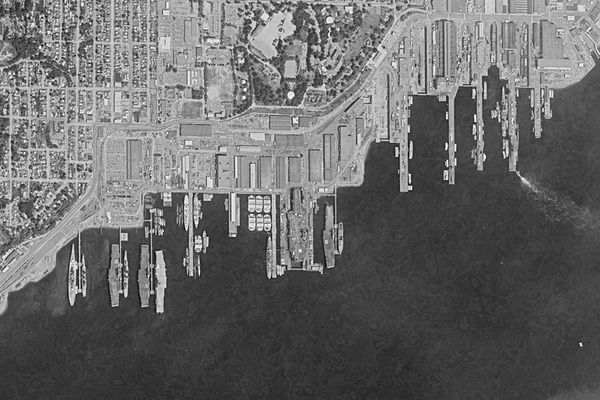 A HEXAGON satellite took this photo of Bremerton, Washington, in June 1982. At far left the battleship USS Missouri is pierside. She would be towed to a drydock and modernized in the next few years. This was in response to the perceived increased Soviet Navy threat. USS Oriskany is also docked. After a long period of inactivity, she was later towed to Florida and sunk as an artificial reef. (credit: Harry Stranger) |
Although the Navy was modernizing in the 1970s and 1980s with new cruisers, destroyers, and frigates, the Navy still kept many older ships in reserve. A 1978 satellite photo of Suisun Bay, northeast of San Francisco, shows dozens of World War II era cargo ships in mothballs. They were never returned to service. An October 1983 American HEXAGON satellite photo further makes the case. It showed five US Navy aircraft carriers moored at Bremerton, Washington. One of those ships, USS Hornet, would eventually become a museum. Two others, Bennington and Bonhomme Richard, were scrapped. Nearby, the supercarrier USS Constellation was undergoing a service life extension and would continue to serve another two decades before being retired. The Mighty O and Mighty Mo were also in the photo. Missouri would soon undergo refit. Soviet satellites undoubtedly photographed the same shipyard, looking for the first signs that any of the ships were being moved to drydock for refurbishment. The battleship reactivation demonstrated that mothballed ships were very expensive to put back in service.
Oriskany sat slowly rusting at several piers from 1976 until 2006, when she was finally towed out to sea and sunk off the coast of Florida as a diving attraction. She can no longer be seen from space.
Notes
Central Intelligence Agency, National Foreign Intelligence Center, “Status of Soviet Construction Programs for Major Surface Combatants, December 1980,” February 1981. CIA FOIA Reading Room CIA-RDP81T00380R000100500001-7
Central Intelligence Agency, Directorate of Intelligence, “US and Soviet Major Surface Warships, 1964-85: The Perspective of Inventory Value, “April 1982. CIA FOIA Reading Room CIA-RDP83T00233R000100120001-0
National Photographic Interpretation Center, “Soviet Major Surface Combatant Construction for 1982,” June 1983. CIA FOIA Reading Room CIA-RDP84T00171R000101040001-6
National Photographic Interpretation Center, “445F CG Unit 1, Nikolayev Shipyard Oktyabrskoye, USSR, ” March 1982. CIA FOIA Reading Room CIA-RDP89-00121R000300520004-9
National Photographic Interpretation Center, “Expansion at Nikolayev Shipyard Northern 61 Kommuna 445, USSR, ” December 1984. CIA FOIA Reading Room CIA-RDP85T00060R000300820001-1
Memorandum from Secretary of Defense Harold Brown to President Carter, Washington, July 18, 1980, “Significant Actions, Secretary and Deputy Secretary of Defense (July 12–18, 1980), FY 82 Defense Program,” Foreign Relations of the United States, 1977–1980, Volume IV, National Security Policy, James Graham Wilson, editor, 2024, p. 866.
General Accounting Office, Donald J. Horan, Director, to Joseph P. Addabbo, Chairman, Subcommittee on Defense Committee on Appropriations, House of Representatives, “Update of the Issues Concerning the Proposed Reactivation of the Iowa Class Battleships and the Aircraft Carrier Oriskany,” April 20, 1981.
Wynn F. Foster, Fire on the Hangar Deck: Ordeal of the Oriskany, U.S. Naval Institute Press, 2001.
Peter Fey, Bloody Sixteen: The USS Oriskany and Air Wing 16 During the Vietnam War, Potomac Books, 2018.
Norman Polmar, Aircraft Carriers: A History of Carrier Aviation and its Influence on World Events, Volume II, 1946-2006, Potomac Books, 2008.
“The Nation; More Power to the Military Chiefs,” New York Times, April 5, 1981, Section 4, p. 4.
“Administration Wins Two Tests in Effort to Reactivate Old Ships,” New York Times, April 8, 1981, p. A-16.
“Senate Unit Backs Reagan on Armed Forces Fund,” New York Times, April 29, 1981, p. A-24.
“House Approves $26 Billion Rise in Arms Budget,” New York Times, July 21, 1981, p. A-1.
Soviet Rear Admiral L. Vasyukov and Captain First Rank P. Lapkovskiy wrote “Battleships and Their Combat Employment” Zarubezhnoye Voyennoye Obozreniye, No. 1, Jan 1987, translated in JPRS Report – Soviet Union, Foreign Broadcast Information Service, January 1987.
Note: we are now moderating comments. There will be a delay in posting comments and no guarantee that all submitted comments will be posted.
